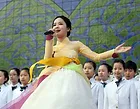About Lesson
Activity 1.2: Who are Korean Americans? Why did they leave Korea and come to the U.S.?
 Students deepen their understanding of who Korean Americans are and why they came to the U.S. by watching documentaries of Korean American history. They explore how immigrant experiences have evolved since 1900. Song So-Hee performing Arirang. (Source: Wikipedia)
Students deepen their understanding of who Korean Americans are and why they came to the U.S. by watching documentaries of Korean American history. They explore how immigrant experiences have evolved since 1900. Song So-Hee performing Arirang. (Source: Wikipedia)
Activity Questions
- Who are Korean Americans?
- Why did they leave Korea and come to the U.S.?
- What was life like for the Koreans who immigrated to Hawaii?
- How were Korean immigrants treated during WW I and WW II?
- What was life like for Korean immigrants in the second wave?
- How have Korean immigrant experiences evolved since 1903?
Instructional Strategies
- To support these activities, use the Lesson 1 Presentation.
Arirang and First Immigrant Wave
- Before Viewing
- Inform students that the first activity in Lesson 1 involved looking at the Korean diaspora and that now we will explore how individual Korean Americans made their decisions to come to the United States.
- Explain the meaning of Arirang and ask students why this documentary was named thus.
- Ask students to list reasons why they think people leave their homes or native countries. Facilitate a brief whole-class discussion of the reasons students listed.
- Briefly introduce the selected excerpt from the documentary, Arirang. (The first nine minutes tell of the first wave of immigration to Hawaii, but other segments are also of value. It is certainly worth taking the time to show the entire video.)
- During Viewing
- As students view the video segment, they may write notes on what the people in the video state related to their reasons for coming to the U.S.
- After Viewing
- Group students in pairs or trios to discuss the reasons Koreans came to the U.S. Ask student groups to create a list of reasons why Koreans came to the U.S.
- Once groups have created their own lists, then invite groups to share with the class the lists they created in their groups. As students share, compile a class list on the board or using technology that can be projected for student view.
- Facilitate a discussion (can be whole group or small groups) of the reasons Koreans came to the U.S. Be sure to invite students to consider and share their own family experiences with immigration. What similarities and differences can students identify between their own immigration experience (if any) and that of the Korean experience? For support with making comparisons, you may wish to provide students with a Venn Diagram.
Footsteps of Korean Americans
- Before Viewing
- During Viewing
- Watch the Footsteps of Korean Americans video, stopping at 26:31. While watching, ask students to take note of important dates/experiences of Korean Americans who shared in the video.
- After Viewing
- Direct students to use the information from the video to create a timeline tracing Korean Americans’ footsteps as identified in the video. This activity may be assigned as homework or used as an extension activity/follow-up lesson.
Review on Quick Facts
- Distribute QFS: Korean Americans in the U.S. and Activity Worksheet for QFS: Korean Americans in the U.S. to students.
- Individually, or in pairs/small groups, have students find answers to the questions in the activity sheet.
Closing Activity
- End class by reviewing worksheet responses and discussing the activity questions.
Resources
- Lesson 1 Teachers’ Guide and Lesson 1 Presentation are found on Lesson 1 Overview.
- Video: Arirang
- Video: Footsteps of Korean Americans
- Quick Fact Sheet Korean Americans in the U.S.
- Worksheet on Korean Americans in the U.S.
- Additional resources are found under Lesson 1 Overview, Activity 1.1, Activity 1.2, Lesson 1 Videos, Lesson 1 Assessments, and Lesson 1 Research Extension.
Handout: QFS: Korean Americans in the U.S. (PDF)
Worksheet: Korean Americans in the U.S. (PDF)

